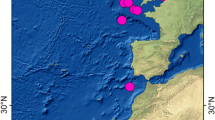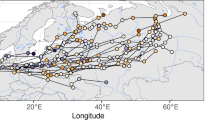Abstract
Birds migrating along coastlines may be at increased risk if displacement occurs toward open-ocean. Eastern North America experiences prevailing northwesterly winds during autumn, which could compel some migrants to drift eastward. Therefore, migrants at stop-over sites along this route may be a mixture of on- and off-course individuals. We assessed whether orientation behavior of juvenile yellow-rumped warblers (Dendroica coronata) captured at a stop-over site in southern Nova Scotia was related to where they originated from (i.e., likely on/off-course). We hypothesized three scenarios after displacement: 1) continued orientation in the migratory direction selected before displacement, 2) orientation from the new location toward the previous destination, or 3) correction to regain the original pathway. Using stable isotopes, we determined that stop-over migrants originated from nearby areas (and assumed on-course) and as far away as western Hudson Bay, over 1,600 km northwest (and assumed off-course) of the site. We used video-based orientation registration cages to determine an individuals’ migratory orientation. Because numerous factors influence migratory orientation (e.g., fuel reserves, celestial cues), we simultaneously assessed the influence of body condition and cloud cover, in addition to geographic origin, on orientation behavior. Individuals that originated closer to the site tended to orient more southwesterly. Orientation directions became increasingly more west-northwesterly the further away an individual originated from the site (i.e., the more likely it was to have been displaced). The result is most consistent with scenario three: individuals from northwest origins likely respond to easterly displacement by orienting westerly to reestablish their previous migratory route.



Similar content being viewed by others
References
Able KP (1977) The orientation of passerine nocturnal migrants following offshore drift. Auk 94:320–330
Able KP (1980) Mechanisms of orientation, navigation, and homing. In: Gauthreaux SA (ed) Animal migration, orientation, and navigation. Academic Press, London, pp 283–373
Able KP (1993) Orientation cues used by migratory birds: a review of cue-conflict experiments. Trends Ecol Evol 8:367–371
Åkesson S (2003) Avian long-distance navigation: experiments with migratory birds. In: Berthold P, Gwinner E, Sonnenschein E (eds) Avian migration. Springer-Verlag, Berlin, pp 471–492
Åkesson S, Karlsson L, Walinder G, Alerstam T (1996) Bimodal orientation and the occurrence of temporary reverse bird migration during autumn in south Scandinavia. Behav Ecol Sociobiol 38:93–302
Åkesson S, Morin J, Muheim R, Ottosson U (2005) Dramatic orientation shift of white-crowned sparrows displaced across longitudes in the high arctic. Curr Biol 15:1591–1597
Alerstam T (1990) Ecological causes and consequences of bird orientation. Experientia 46:405–415
Bäckman J, Pettersson J, Sandberg R (1997) The influence of fat stores on magnetic orientation in day-migrating chaffinch, Fringilla coelebs. Ethology 103:247–256
Baird J, Nisbet ICT (1960) Northward fall migration on the Atlantic coast and its relation to offshore drift. Auk 77:119–149
Batschelet E (1981) Circular statistics in biology. Academic, London
Bowen GJ, Wassenaar LI, Hobson KA (2005) Global application of stable hydrogen and oxygen isotopes to wildlife forensics. Oecologia 143:337–348
Brewer D, Diamond A, Woodsworth EJ, Collins BT, Dunn EH (2000) Canadian atlas of bird banding. Canadian Wildlife Service, Canada
Bruderer B, Liechti F (1998) Flight behaviour of nocturnally migrating birds in coastal areas — crossing or coasting. J Avian Biol 29:499–507
Butler RW (2000) Stormy seas for some North American songbirds: are declines related to severe storms during migration? Auk 117:518–522
Cain SD, Boles LC, Wang JH, Lohmann KJ (2005) Magnetic orientation and navigation in marine turtles, lobsters, and molluscs: concepts and conundrums. Integr Comp Biol 45:539–546
Chamberlain CP, Blum JD, Holmes RT, Feng X, Sherry TW, Graves GR (1997) The use of isotope tracers for identifying populations of migratory birds. Oecologia 109:132–141
Desante DF (1973) An analysis of the fall occurrences and nocturnal orientations of vagrant wood warblers (Parulidae) in California. PhD Dissertation. Stanford University, Stanford
Dittman AH, Quinn TP (1996) Homing in Pacific salmon: mechanisms and ecological basis. J Exp Biol 199:83–91
Drury WH, Keith JA (1962) Radar studies of songbird migration in coastal New England. Ibis 104:449–489
Drury WH, Nisbet IC (1964) Radar studies of orientation of songbird migrants in southeastern New England. Bird Banding 35:69–119
Dunn E, Hobson KA, Wassenaar LI, Hussell DJT, Allen ML (2006) Identification of summer origins of songbirds migrating through southern Canada in autumn. Avian Conserv Ecol 1 [Online.] URL: http://www.ace-eco.org/vol1/iss2/art4/
Emlen ST, Emlen JT (1966) A technique for recording migratory orientation of captive birds. Auk 83:361–367
Erni B, Liechti F, Bruderer B (2005) The role of wind in passerine autumn migration between Europe and Africa. Behav Ecol 16:732–740
Evans PR (1968) Reorientation of passerine night migrants after displacement by the wind. Br Birds 61:281–303
Fisher NI, Lee AJ (1992) Regression models for an angular response. Biometrics 48:665–677
Fitzgerald T (2004) Orientation behavior of yellow-rumped warbler (Dendroica coronata). MSc Thesis. Acadia University, Wolfville
Gauthreaux SA (1978) Importance of daytime flights of nocturnal migrants: redetermined migration following displacement. In: Schmidt-Koenig K, Keeton WT (eds) Animal migration, navigation, and homing. Proc Life Sci. Springer, Berlin, pp 219–227
Helbig AJ (1991) Inheritance of migratory direction in a bird species: a cross-breeding experiment with SE- and SW-migrating blackcaps (Sylvia atricapilla). Behav Ecol Sociobiol 28:9–12
Helbig AJ, Berthold P, Wiltschko W (1989) Migratory orientation of Blackcaps Sylvia atricapilla: population-specific shifts of direction during the autumn. Ethology 82:307–315
Hobson KA (2003) Making migratory connections with stable isotopes. In: Berthold P, Gwinner E, Sonnenschein E (eds) Avian migration. Springer-Verlag, Berlin Heidelberg New York, pp 379–391
Hobson KA (2005) Stable isotopes and the determination of avian migratory connectivity and seasonal interactions. Auk 122:1037–1048
Hobson KA, Wassenaar LI (1997) Linking breeding and wintering grounds of neotropical migrant songbirds using stable hydrogen isotopic analysis of feathers. Oecologia 109:142–148
Hunt PD, Flaspohler DJ (1998) Yellow-rumped Warbler. Birds N Am 376:1–26
Jammalamadaka SR, SenGupta A (2001) Topics in circular statistics. World Scientific, Singapore
Jammalamadaka SR, Lund UJ (2006) The effect of wind direction on ozone levels: a case study. Environ Ecol Stat 13:287–298
Jardine TD, Cunjak RA (2005) Analytical error in stable isotope ecology. Oecologia 144:528–533
Jenni L, Schaub M (2003) Behavioral and physiological reactions to environmental variation in bird migration: a review. In: Berthold P, Gwinner E, Sonnenschein E (eds) Avian migration. Springer-Verlag, Berlin, pp 155–171
Kelly JF, Atudorei V, Sharp ZD, Finch DM (2002) Insights into Wilson’s warbler migration from analysis of hydrogen stable-isotope ratios. Oecologia 130:216–221
Langin KM, Reudink MW, Marra PP, Norris DR, Kyser TK, Ratcliffe LM (2007) Hydrogen isotopic variation in migratory bird tissues of known origin: implications for geographic assignment. Oecologia 152:449–457
Lindström A, Alerstam T (1986) The adaptive significance of reoriented migration of chaffinches Fringilla coelebs and bramblings F. montifringilla during autumn in southern Sweden. Behav Ecol Sociobiol 19:417–424
Lott CA, Smith JP (2006) A Geographic-Information-System approach to estimating the origin of migratory raptors in North America using stable hydrogen isotope ratios in feathers. Auk 123:822–835
Mazerolle DF, Hobson KA, Wassenaar LI (2005) Stable isotope and band-encounter analyses delineate migratory patterns and catchment areas of white-throated sparrows at a migration monitoring station. Oecologia 144:541–549
McLaren IA (1981) The incidence of vagrant landbirds on Nova Scotian islands. Auk 98:243–257
McLaren IA, Maybank B, Keddy K, Taylor PD, Fitzgerald T (2000) A notable autumn arrival of reverse-migrants in southern Nova Scotia. N Am Birds 54:4–10
McLaren IA, Lees AC, Field C, Collins KJ (2006) Origins and characteristics of Nearctic landbirds in Britain and Ireland in autumn: a statistical analysis. Ibis 148:707–726
Meehan TD, Giermakowski JT, Cryan PM (2004) GIS-based model of stable hydrogen isotope ratios in North American growing season precipitation for use in animal movement studies. Isot Environ Heath Stud 40:291–300
Moore FR (1990) Evidence for redetermination of migratory direction following wind displacement. Auk 107:425–428
Moore FR, Phillips JB (1988) Sunset, sky-light polarization and the migratory orientation of yellow-rumped warblers, Dendroica coronata. Anim Behav 36:1770–1778
Mouritsen H (2001) Navigation in birds and other animals. Image Vis Comput 19:713–731
Mouritsen H, Larsen ON (1998) Migrating young pied flycatchers Ficedula hypoleuca do not compensate for geographical displacements. J Exp Biol 201:2927–2934
Muheim R, Phillips JB, Åkesson S (2006a) Polarized light cues underlie compass calibration in migratory songbirds. Science 313:837–839
Muheim R, Moore FR, Phillips JB (2006b) Calibration of magnetic and celestial compass cues in migratory birds—a review. J Exp Biol 209:2–17
Newton I (2007) Weather-related mass-mortality events in migrants. Ibis 149:453–467
Nievergelt F, Liechti F, Bruderer B (1999) Migratory directions of free-flying birds versus orientation in registration cages. J Exp Biol 202:2225–2231
Nisbet ICT, McNair DB, Post W, Williams TC (1995) Transoceanic migration of the blackpoll warbler: summary of scientific evidence and response to criticisms by Murray. J Field Ornithol 66:612–622
Peckford ML, Taylor PD (2008) Within night patterns of correlations between Radar and ground counts of migrating songbirds depend on wind direction. Journal of Field Ornithology (in press)
Perdeck AC (1958) Two types of orientation in migrating Sturnus vulgaris and Fringilla coelebs as revealed by displacement experiments. Ardea 46:1–37
Pyle P (1997) Identification guide to North American Birds, Part 1. Slate Creek, Bolinas
Ralph CJ (1978) Disorientation and possible fate of young passerine coastal migrants. Bird Banding 49:237–247
Richardson WJ (1972) Autumn migration and weather in eastern Canada: a radar study. Am Birds 26:10–16
Richardson WJ (1978) Reorientation of nocturnal landbird migrants over the Atlantic Ocean near Nova Scotia in autumn. Auk 95:717–732
Richardson WJ (1980) Autumn landbird migration over the western Atlantic Ocean as evident from radar. In: Proceedings of the 17th International Ornithological Congress. Berlin, pp 501–506
Richardson WJ (1982) Northeastward reverse migration of birds over Nova Scotia, Canada, in Autumn. Behav Ecol Sociobiol 10:193–206
Richardson WJ (1985) The influence of weather on orientation and numbers of avian migrants over eastern Canada: a review. Contrib Mar Sci 27:604–617
Richardson WJ (1990) Wind and orientation of migrating birds: a review. Experientia 46:416–425
Sandberg R, Moore FR (1996) Migratory orientation of red-eyed vireos, Vireo olivaceus, in relation to energetic condition and ecological context. Behav Ecol Sociobiol 39:1–10
Sandberg R, Moore FR, Bäckman J, Lõhmus M (2002) Orientation of nocturnally migrating Swainson’s thrush at dawn and dusk: importance of energetic condition and geomagnetic cues. Auk 119:201–209
Scapini F, Rossano C, Marchetti GM, Morgan E (2005) The role of the biological clock in the sun compass orientation of free-running individuals of Talitrus saltator. Anim Behav 69:835–843
Thorup K, Rabol J (2007) Compensatory behaviour after displacement in migratory birds. Behav Ecol Sociobiol 61:825–841
United States Naval Observatory (Department of United States Navy), Astronomical Applications Department, Data Services: Sun or Moon Altitude/Azimuth Table for One Day. (2003) Retrieved on 11th November 2002 from the World Wide Web: http://aa.usno.navy.mil/
Wassenaar LI, Hobson KA (2001) A stable-isotope approach to delineate geographical catchment areas of avian migration monitoring stations in North America. Environ Sci Technol 35:1845–1850
Wassenaar LI, Hobson KA (2003) Comparative equilibration and online techniques for determination of non-exchangeable hydrogen of keratins for use in animal migration studies. Isot Environ Health Stud 39:211–217
Wiltschko R, Wiltschko W (2003) Mechanisms of orientation and navigation in migratory birds. In: Berthold P, Gwinner E, Sonnenschein E (eds) Avian migration. Springer-Verlag, Berlin, pp 433–456
Acknowledgments
This project received financial support from Acadia University, the Atlantic Cooperative Wildlife Ecology Research Network, and the Government of Canada’s Climate Change Impacts and Adaptation Program. We appreciate the efforts of L. Adams, R. Fitzgerald, M. O’Brien, and R. Watkins, who all provided valuable logistical support. We also thank A. Bond, W. Fitzgerald, P. Goulet, J. Nocera, and M. Peckford for field assistance. D. Crooks and A. Mitchell provided lab space, equipment, and experience that aided in processing videotaped trials. A. Mullie assisted with the graphics. This manuscript benefited from comments by J. Nocera, D. Shutler, and several anonymous reviewers. Scientific permits to hold yellow-rumped warblers in captivity were obtained from Canadian Wildlife Service. The experiments complied with the laws of Canada at the time they were done.
Author information
Authors and Affiliations
Corresponding author
Additional information
Communicated by W. Wiltschko
Rights and permissions
About this article
Cite this article
Fitzgerald, T.M., Taylor, P.D. Migratory orientation of juvenile yellow-rumped warblers (Dendroica coronata) following stopover: sources of variation and the importance of geographic origins. Behav Ecol Sociobiol 62, 1499–1508 (2008). https://doi.org/10.1007/s00265-008-0579-3
Received:
Revised:
Accepted:
Published:
Issue Date:
DOI: https://doi.org/10.1007/s00265-008-0579-3




